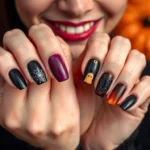We know the struggle of finding the perfect natural hairstyle that celebrates your gorgeous curls while fitting your lifestyle. Black women’s natural hair textures offer endless possibilities, but handling the industry of curl patterns and styling techniques can feel overwhelming.
Whether you’re transitioning from relaxed hair or simply looking to switch up your current routine, natural hairstyles unlock your hair’s true potential. From protective styles that promote healthy growth to wash-and-go looks that showcase your natural texture, the options are limitless and empowering.
We’ve curated the most stunning and versatile natural hairstyles specifically designed for curly-haired Black women. These styles aren’t just beautiful – they’re practical, hair-healthy, and perfect for every occasion from boardroom meetings to weekend adventures.
Twist-Outs for Definition and Volume
Twist outs create stunning definition while adding impressive volume to natural curls. We’ve mastered these techniques to help you achieve salon quality results at home.
Two-Strand Twist Method
Two strand twists form the foundation of most twist out styles for curly haired Black women. Start with damp hair that’s been freshly washed and conditioned for optimal results. Section your hair into 1 to 2 inch pieces depending on your desired volume level.
Apply your chosen styling product from root to tip using praying hands method. Take each section and divide it into two equal parts. Twist the strands around each other in a consistent direction while maintaining tension. Secure each twist with a small elastic or bobby pin if needed.
Sleep with a silk scarf or bonnet to protect your twists overnight. Remove the twists carefully in the morning by unraveling them in the opposite direction. Fluff gently at the roots using your fingers to create volume without disturbing the curl pattern.
Three-Strand Twist Technique
Three strand twists offer more intricate definition patterns than their two strand counterparts. Begin with the same damp hair preparation process used for two strand twists. Divide each section into three equal parts instead of two for this braiding style technique.
Cross the right strand over the middle strand first. Move the left strand over the new middle strand next. Continue this alternating pattern down to the ends while keeping consistent tension throughout. This method creates tighter coils that result in more pronounced definition.
Allow 6 to 8 hours of drying time for three strand twists since they’re denser. Take down each twist by gently separating the three strands with your fingertips. Shake out the roots to achieve maximum volume and definition.
Products for Long-Lasting Results
| Product Type | Purpose | Application Time |
|---|---|---|
| Leave-in conditioner | Moisture retention | 2-3 minutes |
| Curl defining cream | Shape enhancement | 3-4 minutes |
| Gel or custard | Hold and frizz control | 1-2 minutes |
| Oil sealant | Shine and protection | 30 seconds |
Moisture rich leave in conditioners provide the hydration base that curly hair needs for healthy twist outs. Apply these products to damp hair using the praying hands method to smooth the cuticles. Focus on the mid lengths and ends where hair tends to be driest.
Curl defining creams enhance your natural curl pattern while providing medium hold. Work these products through each section before twisting to ensure even distribution. Choose alcohol free formulas to prevent drying and brittleness.
Lightweight oils like jojoba or argan seal in moisture after applying water based products. Use just a few drops per section to avoid weighing down your curls. This final step adds shine and protects against environmental damage for twist outs that last 3 to 5 days.
Bantu Knots for Texture and Style

Bantu knots offer a protective styling option that showcases our hair’s natural texture while creating sculptural, defined knots. This versatile technique works exceptionally well for curly and coily hair textures, transforming them into voluminous styles that protect against heat and environmental damage.
Traditional Bantu Knot Setup
Setting up traditional Bantu knots begins with sectioning clean, moisturized hair into small or medium parts throughout the head. We twist each section counterclockwise from root to tip, creating tension that enhances our natural curl patterns. Coiling the twisted hair tightly at the base comes next, then we secure each knot with bobby pins or small hair ties.
Products like twisting soufflés or curling creams provide the hold and definition needed for long-lasting results. Applying these styling products before twisting ensures each section maintains its shape while reducing breakage. Even spacing between knots creates a uniform look that highlights the sculptural nature of this protective style.
Bantu Knot-Out Variations
Creating a Bantu knot-out involves unraveling the set knots after our hair has processed, typically overnight or for several hours. This technique reveals springy, spiral curls that add incredible volume to our natural texture. Larger or fewer knots produce looser waves, while smaller, more many knots create tighter curl patterns.
Half-up styling offers another variation where we leave some knots intact while releasing others for a blended effect. Some women prefer combining knot-outs with traditional knots for dimensional styling that showcases different textures. Timing plays a crucial role since longer setting periods typically yield more defined spiral curls.
Styling Tips for Different Hair Lengths
Short hair requires smaller sections and knots to achieve maximum definition and easier nighttime maintenance. Focus on creating tighter knots that won’t unravel during sleep, using clips to secure loose ends.
Medium length hair works best with medium-sized knots that offer styling versatility without becoming too heavy. These knots are easier to manage during sleep and provide balanced volume throughout the head.
Long hair needs larger sections and additional product to keep knots secure overnight. Consider braiding the ends before coiling for extra hold, as longer hair tends to unravel more easily.
All hair lengths benefit from thorough moisturizing and detangling before styling begins. Using sectioning clips keeps hair organized during the setup process, while focusing on proper product distribution ensures consistent results across all knots.
Wash-and-Go Styles for Effortless Beauty

We love wash-and-go styles because they celebrate our natural curl patterns while requiring minimal time and effort. This approach involves washing the hair, applying moisture-rich products, and allowing curls to air-dry naturally for beautiful, frizz-free results.
Curl Improving Product Selection
Leave-in conditioners form the foundation of our wash-and-go routine by detangling and moisturizing curls from root to tip. We apply these lightweight formulas to damp hair immediately after washing to lock in hydration and prevent breakage.
Curl activators and creams add essential moisture while defining our natural curl pattern. These products work best when we distribute them evenly through sectioned hair using the prayer hands method or gentle raking motions.
Gels and curl-defining creams provide the hold we need to maintain our curls throughout the day. We choose alcohol-free formulas that won’t dry out our hair while still offering long-lasting definition and frizz control.
Scrunching Techniques for Maximum Curl
Gentle squeezing motions help us encourage curl formation without disturbing our natural pattern. We scrunch damp hair from the ends upward toward the scalp, supporting each curl as it forms its natural shape.
Microfiber towels or cotton t-shirts replace traditional terry cloth towels in our scrunching routine. These materials reduce friction and prevent frizz while we gently squeeze excess water from our curls.
Upward lifting movements maximize curl elasticity and create volume at the roots. We cup sections of hair in our palms and gently pulse upward, allowing curls to bounce back naturally between each squeeze.
Maintenance Tips for Multi-Day Wear
Silk or satin pillowcases protect our curls while we sleep by reducing friction that causes frizz and flattening. We also use silk scarves or bonnets as an extra layer of protection for delicate curl patterns.
Curl refresher sprays revive our wash-and-go styles on day two and beyond. We lightly mist our hair in the morning and scrunch gently to restore bounce and definition without rewetting completely.
Strategic re-twisting of flattened sections helps maintain our curl pattern throughout the week. We focus on the areas that lose definition first, usually around the crown and sides, by twisting small sections around our fingers before bed.
Protective Updos That Celebrate Natural Texture
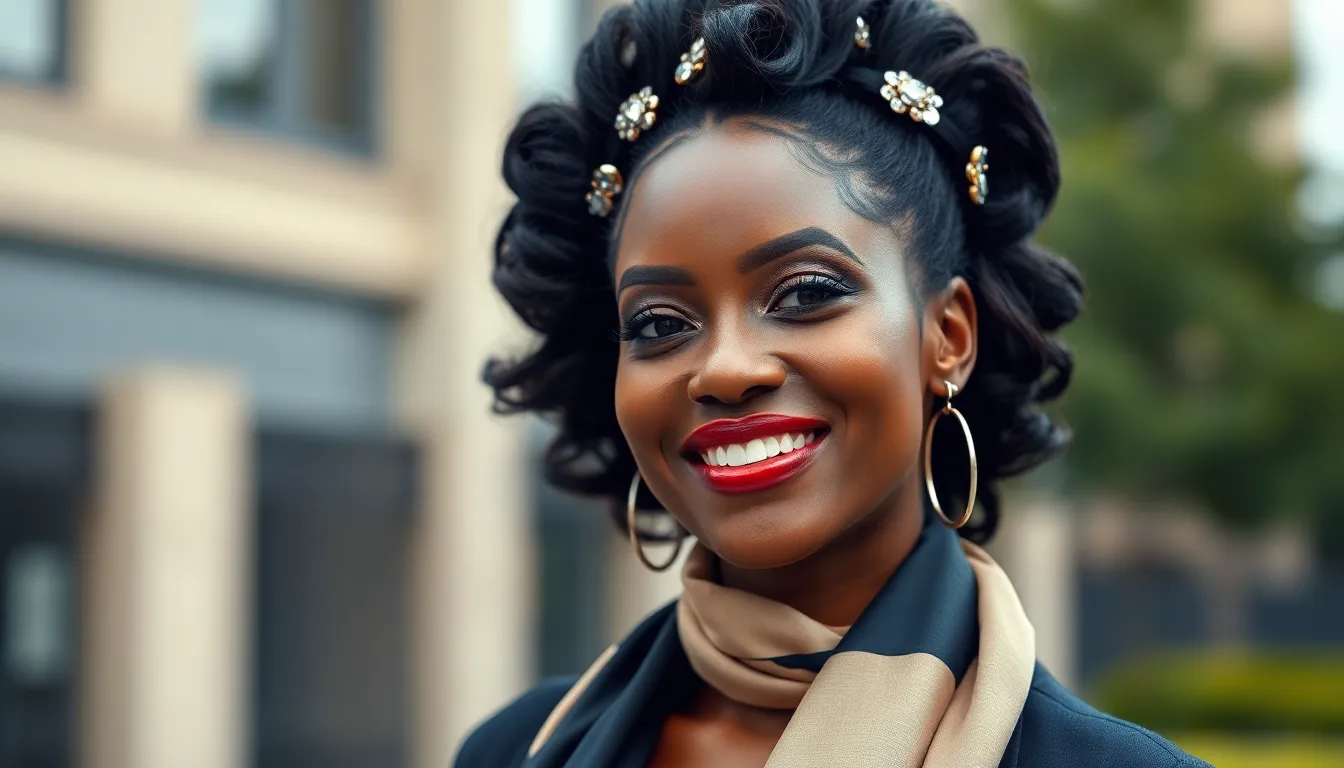
Elevating our natural curls into sophisticated updo styles gives us the perfect balance of protection and elegance. These versatile looks shield our hair from daily manipulation while showcasing the stunning texture we’re blessed with naturally.
High Puff Variations
Creating the perfect high puff starts with gathering moisturized hair at the crown using a soft hair tie or scrunchie. We recommend positioning the puff higher for a more dramatic look or slightly lower for everyday versatility. Adding decorative hairpins, headbands, or silk scarves transforms this simple style into an elegant statement piece.
Securing the puff properly prevents breakage while maintaining our curl pattern throughout the day. Smooth edges with a light gel or edge control product for a polished finish. We can also create volume by gently teasing the puff with our fingers or a wide-tooth comb before setting it in place.
Variations include the side-swept puff, double puff, or braided base puff for added creativity. Each option offers unique styling opportunities while keeping our natural texture as the main focus. These styles work beautifully for both professional settings and casual outings.
Braided Crown Styles
Braided crowns offer an elegant protective style that frames our face while celebrating natural texture. We start by creating small braids around the hairline, working from ear to ear across the front of our head. This technique keeps hair away from our face while adding sophisticated detail to the overall look.
Incorporating our natural curl pattern into crown braids creates stunning visual interest and depth. Leave the remaining hair loose in its natural state or gather it into a low bun for a more formal appearance. We can also weave in colorful ribbon or metallic thread for special occasions.
Crown braids serve as excellent protective styles that minimize daily manipulation and stress on our hairline. These styles typically last 3-5 days with proper nighttime care using silk or satin scarves. Touch up any loose pieces with a small amount of styling cream to maintain the polished appearance.
Twisted Bun Techniques
Twisted buns combine the protective benefits of twisting with the elegance of an updo style. We begin by sectioning damp hair and applying a twisting soufflé or curl cream for hold and definition. Create medium-sized two-strand twists throughout our hair, allowing our natural texture to shine through each twist.
Coiling the completed twists into a low or high bun creates a sophisticated look suitable for any occasion. Secure the bun with bobby pins that match our hair color, ensuring we don’t pull too tightly to avoid tension on our scalp. We can leave a few face-framing twists loose for a softer, more romantic appearance.
Twisted bun variations include the side-swept twisted bun, braided twisted bun, or asymmetrical twisted updo. Each technique offers different levels of formality while maintaining the protective benefits our natural hair needs. These styles can transition seamlessly from day to night with simple adjustments to accessories or positioning.
Flexi Rod Sets for Defined Spiral Curls

Flexi rod sets create uniform and defined spiral curls that offer a polished alternative to wash and go styles. This technique involves wrapping sections of damp hair around flexible plastic rods for elongated, bouncy curls with enhanced definition.
Rod Size Selection Guide
Choosing the right rod diameter transforms your curl pattern and overall look. Small rods measuring 1/4 to 1/2 inch produce tight, springy coils that create maximum definition. Medium rods at 3/4 inch deliver voluminous, ringlet style curls that offer balanced texture and movement. Large rods measuring 1+ inch create loose, beachy waves or relaxed spiral curls for a softer appearance.
| Rod Size | Diameter | Curl Result |
|---|---|---|
| Small | 1/4–1/2 inch | Tight, springy coils |
| Medium | 3/4 inch | Voluminous ringlet curls |
| Large | 1+ inch | Loose waves or relaxed spirals |
Selection depends on your desired curl tightness and hair length. Medium to large rods work particularly well for coily natural hair since they provide elongation and improved manageability.
Setting Techniques for Best Results
Preparation starts with clean, moisturized hair and application of curl defining cream or mousse. Sectioning hair into small, uniform pieces ensures even curling throughout your style. Wrapping each section from ends to roots around the rod maintains smooth, taut placement for consistent results.
Securing each rod with the included clip or elastic prevents unwinding during the drying process. Drying options include air drying for several hours or using a hooded dryer for faster results. Always use wide tooth combs or fingers for detangling during prep to minimize breakage.
Styling Options After Removal
Finger coiling separates and arranges curls for extra definition once you remove the rods. Pineapple updos gather curls on top of the head for a voluminous, elegant look. Half up styles combine defined curls with sleek or textured updos for day to night versatility.
Accessories like headbands, scarves, or clips add accentuation to your finished style. Avoid excessive manipulation after styling to preserve curl structure and minimize frizz. Regular moisturizing between sets maintains optimal curl health for your next flexi rod session.
Finger Coils for Tight Curl Enhancement
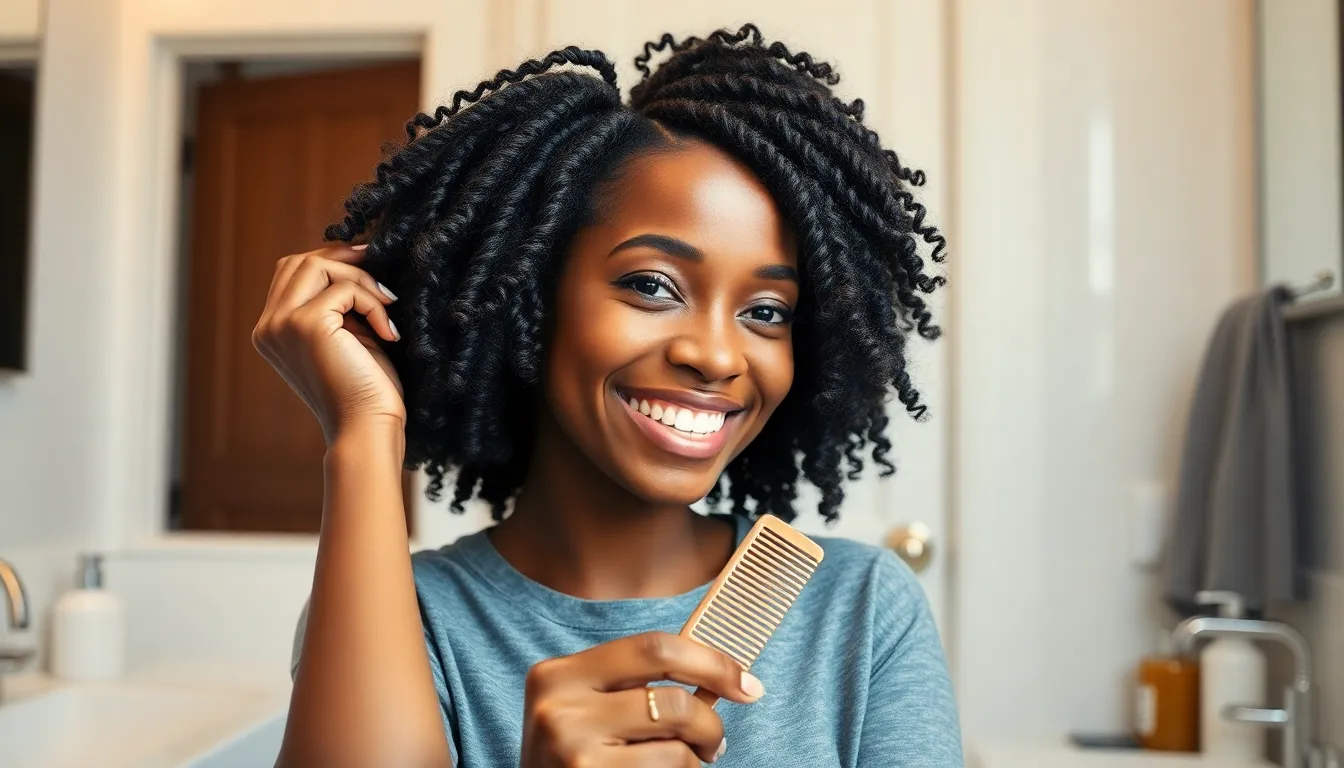
Finger coiling creates defined spiral patterns by manually wrapping small sections of hair around your finger or a rod. This technique hydrates strands while encouraging neat curl formation that can last several days with proper care.
Section Size and Parting Methods
Grid parting systems deliver the most uniform results when creating finger coils. Divide your hair into 1-inch by 1-inch squares using a rat tail comb for precise sectioning and consistent coil placement.
Dense hair textures benefit from smaller ½-inch sections to ensure thorough product distribution and even curl formation. Looser textures can accommodate larger sections up to 1.5 inches without sacrificing definition quality.
Accuracy matters when parting natural hair, so we recommend taking time to create clean lines between sections. Even sectioning prevents uneven curl patterns and ensures each coil receives adequate attention during the styling process.
Product Application Techniques
Leave-in conditioner serves as the foundation for successful finger coils, so apply it to each section before adding styling products. Use the praying hands method to evenly distribute the conditioner from root to tip without disrupting your curl pattern.
Layer curl-defining gel or cream over the conditioner using the same praying hands technique for smooth application. Twist each section while applying product to increase definition and minimize frizz during the coiling process.
Coil each strand from root to tip around your finger or a small rod, maintaining consistent tension throughout. Start with clean, damp hair for optimal product absorption and lasting curl formation that holds its shape for days.
Maintenance and Refresh Tips
Satin or silk pillowcases reduce friction while you sleep, preserving your coil integrity overnight. We suggest wrapping your hair in a silk scarf for additional protection against friction and moisture loss.
Morning refresh routines keep your coils looking fresh without heavy product buildup. Lightly mist curls with water-based spray and apply a small amount of curl cream or oil to redefine any flattened sections.
Gentle finger detangling maintains coil shape better than brushes or combs that can disrupt curl patterns. Re-twist roots as needed to keep coils tidy and prevent frizz from developing at the base of each section.
Pineapple Method for Overnight Curl Preservation
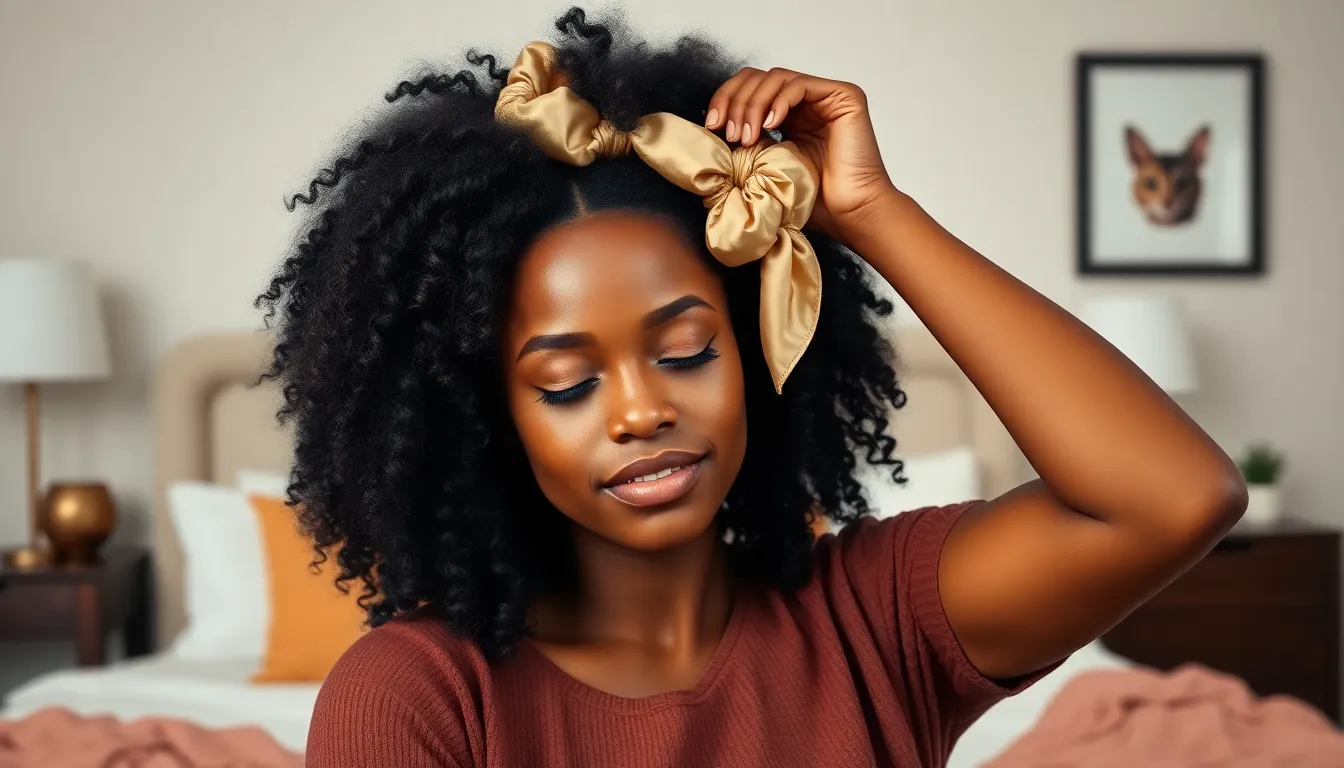
We’ll master the art of preserving our beautiful curls while we sleep using this game changing technique. This method prevents flattening and maintains curl definition by gathering hair at the very top of our head.
Proper Positioning Techniques
Position your curls loosely at the crown of your head using a silk scrunchie or hair tie. Sleep on your back when possible to avoid crushing curls against the pillow. Turn your head side to side gently if you’re a side sleeper to prevent one sided flattening.
Create a high ponytail that sits above your ears and forehead hairline. Avoid pulling the hair tie too tight as this can create dents and breakage. Fluff the gathered curls slightly to maintain their natural shape and volume.
Use a satin pillowcase to reduce friction even when using the pineapple method. Elevate your head with an extra pillow to minimize contact between curls and bedding. Position the ponytail so it falls naturally without bending or crushing the curl pattern.
Silk Scarf and Bonnet Options
Wrap a silk scarf around your hairline before creating the pineapple to provide extra protection. Choose bonnets made from 100% mulberry silk or high quality satin for maximum curl preservation. Secure the bonnet properly so it doesn’t slip off during sleep but isn’t too tight around the edges.
Select scarves that are large enough to cover your entire head without stretching the fabric. Tie the scarf using the turban method with the knot positioned at the nape of your neck. Look for bonnets with adjustable straps or elastic bands that won’t leave marks on your forehead.
Invest in multiple scarves and bonnets so you always have clean options available. Choose colors that complement your sleepwear and make you feel confident. Replace worn items every 6 to 8 months to maintain their protective qualities.
Morning Refresh Routine
Gently remove the hair tie or scrunchie by sliding it down rather than pulling it over the curls. Use your fingers to separate any sections that may have clustered together overnight. Shake your head gently to allow curls to fall into their natural positions.
Apply a curl refreshing spray to damp palms and scrunch it through your hair from mid length to ends. Focus on areas that appear flattened or less defined than others. Work the product through using upward scrunching motions to encourage curl formation.
Flip your head upside down and scrunch curls with a microfiber towel to remove excess moisture. Diffuse on low heat for 2 to 3 minutes if additional volume is needed. Finish by gently fluffing curls at the roots to create lift and movement throughout the day.
Co-Washing Routines for Healthy Curls
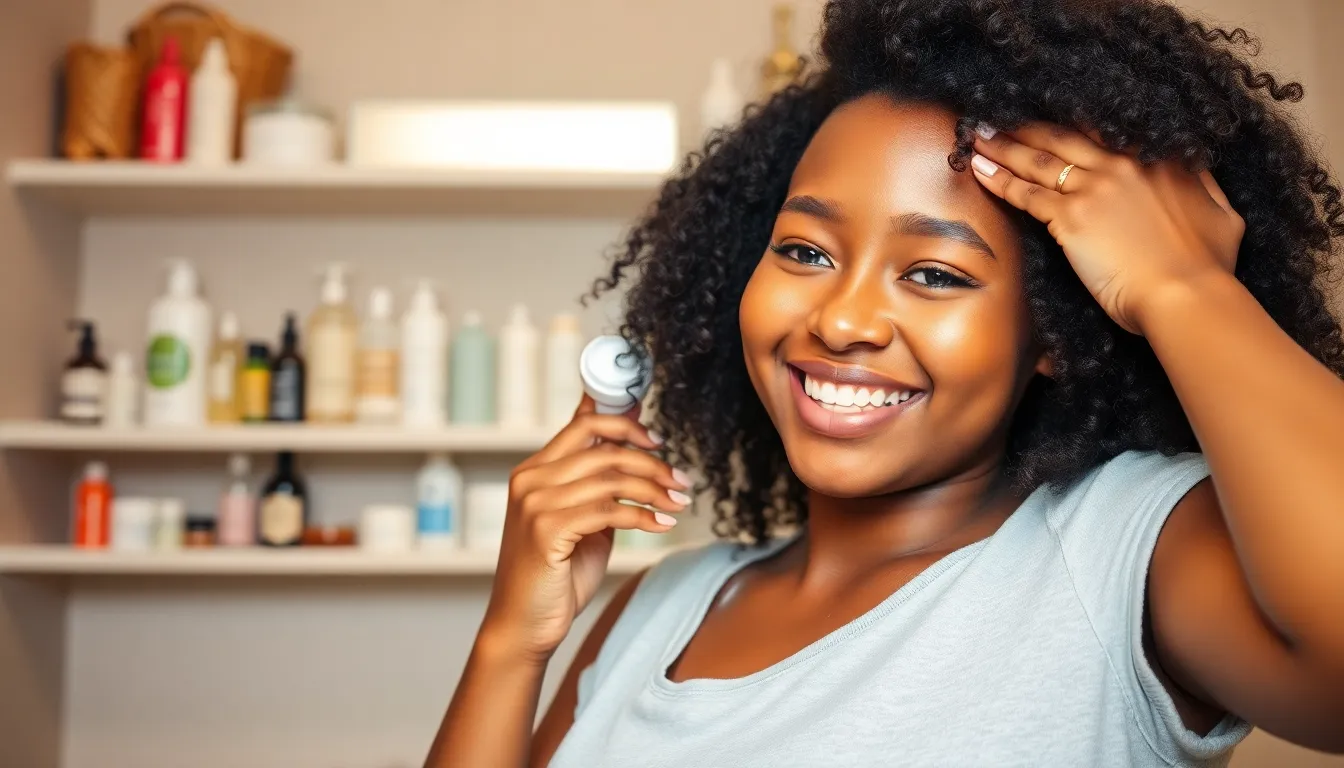
Co-washing revolutionizes how we care for our natural curls by cleansing with conditioner instead of traditional shampoo. This gentle approach helps retain moisture, reduces dryness, and prevents frizz for our curly hair textures.
Product Selection for Curly Hair
Sulfate-free conditioners work best for our co-washing routines since they cleanse gently without stripping natural oils. Look for moisturizing ingredients like shea butter, coconut oil, and glycerin that nourish our curls from root to tip.
Avoid harsh ingredients such as sulfates, drying alcohols, and heavy silicones that can weigh down our hair or cause buildup. These ingredients often leave our curls feeling stripped and brittle instead of soft and hydrated.
Choose products specifically formulated for curly or coily hair textures since they’re designed to work with our unique curl patterns. These specialized formulas understand the porosity and moisture needs of textured hair.
Frequency and Technique Guidelines
Co-wash 1-2 times per week depending on your hair’s porosity and lifestyle factors like exercise frequency or environmental exposure. Higher porosity hair may benefit from more frequent co-washing sessions.
Saturate your hair thoroughly with lukewarm water before applying conditioner to ensure even distribution throughout all sections. This preparation step helps the conditioner penetrate more effectively.
Massage the conditioner gently into your scalp using your fingertips, focusing on cleansing the scalp without creating tangles in your curls. Work the product through to your ends using a smoothing motion.
Rinse thoroughly to remove all product residue while maintaining your curl pattern’s integrity. Incomplete rinsing can lead to buildup that weighs down your natural texture.
Regular shampooing every 2-4 weeks helps remove any accumulated buildup that co-washing alone can’t eliminate. This deeper cleanse keeps our scalp healthy and our curls bouncy.
Deep Conditioning Integration
Deep condition weekly or bi-weekly to restore moisture and elasticity that daily styling and environmental factors can deplete. This intensive treatment keeps our curls strong and resilient.
Apply rich, hydrating deep conditioners from roots to ends, ensuring every strand receives nourishment. Focus extra attention on your ends, which tend to be the driest part of your hair.
Cover with a shower cap and allow the treatment to sit for 20-30 minutes to maximize penetration. The heat trapped under the cap helps open the hair cuticle for better absorption.
Rinse completely with cool water to seal the cuticle and lock in the moisture benefits. This final step enhances shine and reduces frizz for smoother, more defined curls.
Diffusing Techniques for Faster Drying
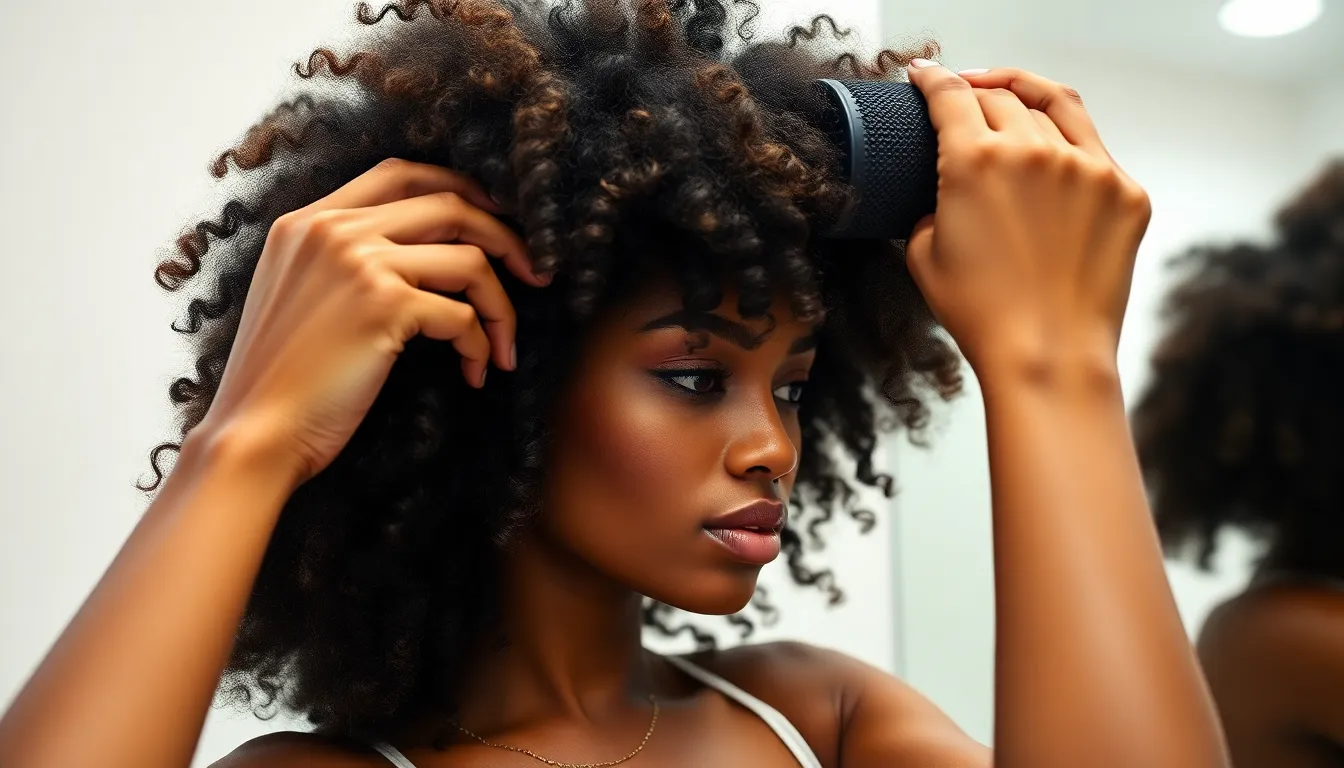
Mastering the art of diffusing transforms your curly hair routine from a time-consuming chore into an efficient styling process. We’ll explore proven techniques that deliver salon-quality results while protecting your natural texture.
Heat Settings and Attachment Types
Low to medium heat settings protect your curls from excessive damage while maintaining beautiful definition. We recommend starting with the lowest heat setting and gradually increasing only if needed, as frequent high-heat styling can compromise curl integrity.
Wide-toothed diffuser attachments work best for curly hair because they distribute airflow evenly across larger sections. These specialized attachments prevent concentrated heat from disrupting your curl pattern while encouraging natural clumping.
Cold air shots become your finishing touch for locking in curl definition and minimizing frizz. We suggest ending every diffusing session with 30 seconds of cool air to seal the hair cuticles and set your style for longer-lasting results.
Proper Hand Positioning
Cupping methods create the foundation for successful diffusing by placing hair sections directly into the diffuser bowl. We position the diffuser close to the scalp, allowing curls to rest naturally in the attachment while maintaining maximum volume at the roots.
Gentle upward movements prevent curl disruption while ensuring even heat distribution throughout each section. Avoid aggressive motions that can separate curl clumps and create unwanted frizz.
Hands-off approaches work best once you’ve positioned the diffuser correctly. We resist the urge to touch or manipulate wet curls during the drying process, as this interference often leads to frizz and undefined curl patterns.
Time-Saving Tips and Tricks
Sectioning hair into manageable portions before diffusing reduces overall drying time while ensuring thorough coverage. We divide hair into 4-6 sections using clips, allowing us to focus on one area at a time for consistent results.
Microfiber towels absorb excess moisture more effectively than regular terry cloth towels. We gently press these specialized towels against wet curls to remove surface water before beginning the diffusing process.
Partial air drying cuts down on heat exposure while speeding up the overall routine. We allow hair to air dry for 10-15 minutes before using the diffuser, reducing the time needed for complete drying.
Pineappling preserves overnight curl definition by loosely securing hair at the crown before bed. This technique maintains curl shape while you sleep, reducing morning restyling time and keeping your curls looking fresh.
Conclusion
We’ve shared a comprehensive collection of natural hairstyles and techniques that celebrate the unique beauty of curly hair. From twist-outs and Bantu knots to protective updos and wash-and-go styles, these options offer versatility for every lifestyle and occasion.
The key to successful natural hair styling lies in understanding your curl pattern and using the right products and techniques. Whether you’re mastering finger coiling, perfecting your co-washing routine, or learning proper diffusing methods, consistency and patience will reward you with healthy, vibrant curls.
Remember that your natural hair journey is uniquely yours. We encourage you to experiment with different styles and find what works best for your texture, schedule, and personal preferences. Embrace the versatility of your curls and enjoy the confidence that comes with healthy, beautifully styled natural hair.
Frequently Asked Questions
What is a twist-out and how do I achieve it?
A twist-out is a styling technique that creates defined curls and volume by twisting damp hair into two or three-strand twists, then unraveling them when dry. Apply leave-in conditioner and curl cream to clean, damp hair, create twists throughout your head, let them dry overnight, then gently separate the twists for beautiful, bouncy curls.
How long do Bantu knots need to stay in?
Bantu knots should stay in for at least 4-6 hours or overnight for best results. The longer you leave them in, the more defined your curl pattern will be when you unravel them. For a Bantu knot-out style, leave them in overnight and unravel in the morning for springy, well-defined curls.
What products are essential for a successful wash-and-go?
Essential wash-and-go products include a moisture-rich leave-in conditioner, curl activator or enhancer, and a lightweight gel for hold and frizz control. Apply products to soaking wet hair, scrunch gently to encourage curl formation, then air dry or diffuse on low heat for defined, frizz-free curls.
How often should I co-wash my natural hair?
Co-washing frequency depends on your hair type and lifestyle, but most people with natural hair benefit from co-washing 1-3 times per week. Those with drier hair may co-wash more frequently, while those with oilier scalps may need less. Always follow up with a clarifying shampoo once a week to remove product buildup.
What is the pineapple method for preserving curls overnight?
The pineapple method involves gathering your curls very loosely at the very top of your head with a silk scrunchie before bed. This keeps curls off your pillow and prevents flattening while you sleep. In the morning, remove the scrunchie and gently fluff your curls for refreshed, bouncy hair.
How do I choose the right flexi rod size?
Flexi rod size depends on your desired curl outcome and hair length. Small rods (¼ inch) create tight spirals, medium rods (½ inch) produce loose curls, and large rods (¾ inch or bigger) create waves or loose curls. Consider your natural curl pattern and choose rods that enhance rather than fight your hair’s texture.
What’s the difference between finger coiling and twist-outs?
Finger coiling involves wrapping individual small sections of hair around your finger to enhance natural curl patterns, while twist-outs require twisting larger sections and unraveling them. Finger coiling is ideal for tighter curl patterns and takes longer but provides more uniform definition. Twist-outs work well for various textures and are quicker to install.
How can I make my natural hairstyles last longer?
To extend your natural hairstyles, sleep on silk or satin pillowcases, use a silk scarf or bonnet, refresh curls with a curl refreshing spray, avoid over-manipulation, and deep condition regularly. Protective styling and proper moisture balance are key to maintaining healthy hair and longer-lasting styles.



